Thank you for helping us meet our fundraising goal!
“The alarm bells are deafening… This report must sound a death knell for coal and fossil fuels, before they destroy our planet.” — UN Secretary General António Guterres describing the 2021 IPCC climate report as a “Code Red for Humanity.”
Despite decades of failure, Canada is once again promising to rapidly ramp down our climate pollution even as we rapidly ramp up fossil fuel extraction. The government is even doubling down, claiming we have to expand fossil carbon extraction because we need the extra fossil fuel cash to pay for emissions cutting.
It's an audacious and risky climate message to send the world — that increasing fossil fuel production is compatible with climate safety. If Canada is wrong again, as we have been for 30 years now, we'll be green-lighting climate disaster.
Curious whether any country has been able to pull off this seemingly counter-intuitive combo of extracting more while emitting less, I went digging through the data for Canada and several of its peer nations.
What I found is the opposite. Nations that ramped down their fossil fuel extraction were the ones that cut their emissions, while nations that increased extraction failed.
To illustrate this consistent link between extraction and emissions, I've created a series of charts showing what Canada and a group of its peers have done.
Canada’s peers
The nations I chose to research are the Group of Seven (G7) nations: Canada, France, Germany, Italy, Japan, the United Kingdom, the United States, and the European Union. With just one-sixth of the world population, they hold more than half the world's wealth, produce half the global GDP, and emit a third of global climate pollution.
In short, if humanity is going to avoid a full-blown climate crisis, these advanced wealthy economies — with the most resources, talent, technology, and capacity — will have to lead the way.
I also included two other peer nations that, like Canada, have significantly increased fossil fuel extraction: Australia (coal and gas), and Norway (Europe's biggest oil producer).
Digging more; emitting more
My first chart shows how emissions and extraction have changed since 1990 for all these nations. That year, 1990, is the international baseline year for comparing climate progress between nations.
National emissions changes are shown as solid bars, while the changes in fossil carbon extraction are shown by the paler, dashed-line bars tucked behind them. Green is reductions; red is increases.
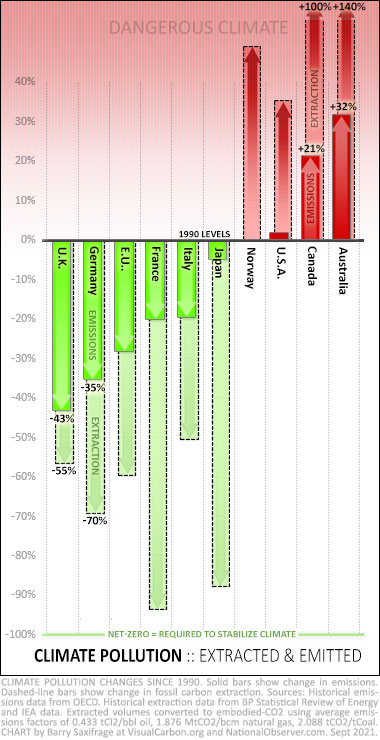
For example, Canada's solid red bar shows our emissions increased 21 per cent since 1990. That's 10 times worse than the Americans, whose emissions rose two per cent over these years. And Canada's red dashed-line bar shows that along the way, we've increased fossil carbon extraction by an off-the-chart 100 per cent. Up and up; red and red.
The most obvious pattern that jumps out at me in this chart — only nations that reduced fossil carbon extraction, cut emissions. These are the double green bars. Clearly, wealthy advanced economies can cut emissions. And they all did it while reducing fossil fuel extraction.
The chart's red bars show the opposite is true. No nation that increased fossil carbon extraction cut emissions. Like Canada, they all promised repeatedly to cut emissions. But none have.
The best science — like the latest Intergovernmental Panel on Climate Change (IPCC) report and the International Energy Agency (IEA) 1.5 C report — are shouting loudly and clearly that all stages of the fossil fuel chain, from extraction through burning, must plunge all the way to net-zero to prevent a full-blown climate crisis. And quickly. That means all those dashed-line extraction bars on the chart have to reach the net-zero line within two to three decades.
That includes Canada.
So, let's next look more closely at extraction trends in individual nations.
Similar start, different directions
I'll start by looking at fossil fuel extraction in Canada — plus the three other nations in the group that were extracting similar amounts in 1990: Australia, Germany, and the U.K.
Back in 1990, Germany was extracting the most in this group. In fact, it was the world's third-biggest coal producer — digging up nearly 900 million tonnes of CO2 (MtCO2) worth of coal alone each year.
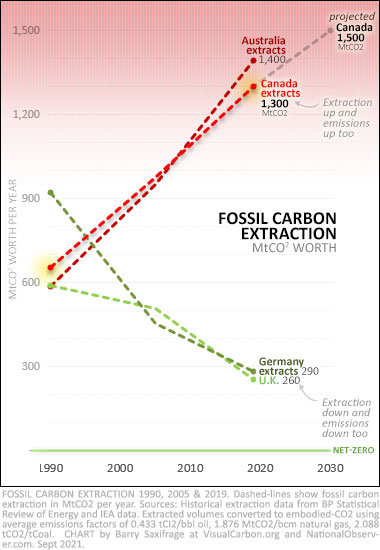
Since then, both the Germans and British significantly reduced their fossil carbon extraction to less than 300 MtCO2 worth per year. As we saw above, all the nations that cut extraction also cut emissions. Sure enough, as extraction fell, Germany's emissions fell 35 per cent and the U.K.'s by 43 per cent. As an additional benefit, these nations have much less work remaining to transition their fossil fuel workers and sector to net-zero.
Canada and Australia took the opposite path. Both doubled the fossil carbon extracted each year. Canada now extracts four times more than the Germans or British do — 1,300 MtCO2 worth per year.
Our relentless increase in fossil carbon extraction has pushed Canadian fossil fuel workers, dependent communities, and the entire oil and gas economic sector ever higher up the net-zero carbon cliff. They now face an eye-wateringly steep transition down to net-zero. And we are throwing away the precious time they need to climb down before the net-zero storm hits with full force.
But apparently, even this dizzying height still isn't risky enough for Canada. The federal government, and many provincial governments, are pushing to climb even higher up that carbon cliff. Under current subsidies and policies, fossil fuel extraction in Canada is projected to jump to around 1,500 MtCO2 worth by 2030. That's setting up an even more dramatic fall should the world decide to save itself from a full-blown climate crisis.
As noted above, Canada claims it is forced to keep extracting more so it can use the fossil fuel cash to pay for emissions cuts. But 30 years of increasing fossil fuel extraction hasn't resulted in either Canada or Australia cutting emissions. Just the opposite.
In contrast, both Germany and the U.K. cut emissions, without that extra fossil cash.
It is almost as if fossil fuel expansion gets in the way.
But if Canada's emissions failure really is caused by too little fossil carbon cash, it raises the burning question of just how much more would be enough?
Norway’s gargantuan pile of oil wealth
Norway is often mentioned as a role model for Canada in amassing fossil fuel wealth and using it to fund emissions cuts. So, let's next look at what the Norwegians have done.
Starting in 1990, this tiny nation set aside oil and gas profits to build up what is now the world's largest sovereign wealth fund, currently valued at US$1.4 trillion.
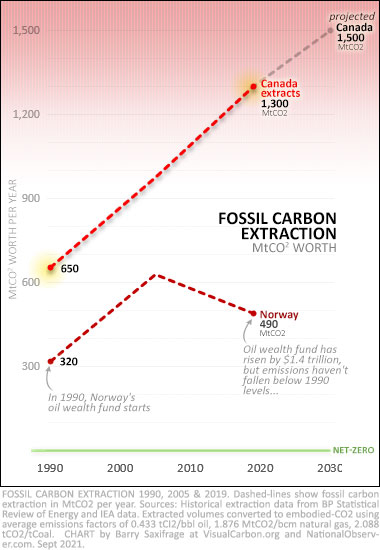
As my next chart shows, back in 1990, Norway was extracting 320 MtCO2 worth of fossil fuels. That was half as much as Canada was extracting back then.
From 1990 to 2005, both nations rapidly increased fossil fuel production. But at that point, Norway's carbon extraction started to fall, while Canada's continued rocketing upwards.
Along the way, Norway built up its gargantuan wealth fund. Surely with this world-record hoard of fossil cash to spend on decarbonizing the rest of its economy, Norway has managed to slash its national emissions. What? It is still emitting as much climate pollution as it did in 1990?
Norway's oil wealth fund now holds a quarter-million dollars per Norwegian. That's far more than Canada could possibly amass in the few years remaining until net-zero.
If Norway can't get its emissions on a safe climate path with all that Smaugian hoard of fossil fuel cash, maybe fossil fuel money isn't the solution after all.
Perhaps, the reality is no amount of increased fossil carbon revenue has been enough to counteract the increased power that an expanding fossil fuel industry has to block progress. Industry has shown repeatedly over the decades it will use whatever power it has to lock in climate failure by weakening climate policies and pushing through climate-crushing amounts of new fossil fuel-burning infrastructure.
The clear pattern in this data shows the nations that have increased the financial and political power of the fossil fuel industry have failed to cut emissions.
And as a double-cautionary note from Norway's experience, not only has Norway failed to use its gargantuan hoard of fossil fuel money to cut emissions as required for a safe climate, but as Bloomberg News reports: “Norway’s wealth fund, through its portfolio holdings, emits twice as much carbon dioxide as the entire country.” The fund continues to resist pressure to put climate targets on its investments. Its fossil money instead supports expansion of fossil fuel extraction around the world. Extraction begets extraction — right off the climate cliff.
No fossil cash to spend
One last group in this mix of Canada's peers — Japan, France, and Italy — is in the opposite situation as Norway. They get almost no money from extracting fossil carbon. That's because they produce so little of it.
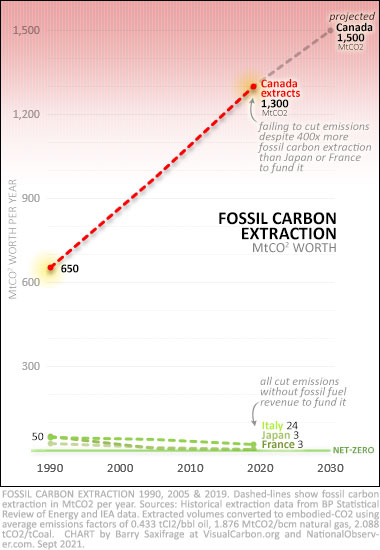
In 1990, Japan, France, and Italy extracted very little fossil carbon. Today, they all extract even less. Japan and France are down to just 3 MtCO2 worth per year. That's 400 times less than Canada.
And yet, despite having essentially no fossil carbon revenue to spend on decarbonizing, all three nations managed to cut their emissions since 1990.
Canada, in contrast, has hundreds of times more fossil fuel cash to spend on decarbonizing, but its emissions continue to climb.
Like an addict, Canada claims that this time will be different if we are just allowed to extract even more of the problem.
If Canada finally wants to reduce its oversized climate pollution — as required to prevent locking in a miserable and dangerous climate future — we should try what has actually worked for our peers: reducing the amount of fossil carbon that gets pulled out of the ground.
The Germans did it. They ramped down their sizable coal industry when it was the world's third-largest.
The British did it. They pulled off a trifecta by ramping down their coal, oil, and gas sectors.
The Japanese, French, and Italians did it.
The European Union did it.
Even Norway has started ramping down oil production in the last decade. Its emissions peaked along with its oil production in the mid-2000s and have now started to fall.
At this point in the metastasizing climate crisis, Canada needs to follow suit.
Cutting the amount of climate pollution that gets dug up in our nation will reduce our emissions.
It will also shrink the power the fossil fuel industry has used to lock in climate failure and block the path to a safe-and-sane climate future.
And it will finally get our nation started on the critical task of helping Canadian fossil fuel workers, dependent communities, and even our banks and pension funds get down off the threatening net-zero carbon cliff before they get shoved off over the edge by global trends they can't control.
---------
Endnotes
To determine how much fossil carbon each nation extracted, I started with fossil fuel production data from BP's Statistical Review of Energy and filled in a few gaps for the smallest-producing nations using the IEA's fossil fuel production data. Fossil fuel extraction data is listed in three parts: for oil, for methane gas, and for coal.
I then converted these fossil fuel production quantities into millions of tonnes of CO2 (MtCO2) using standard emissions factors: 0.433 MtCO2 per million barrels of oil; 1.876 MtCO2 per billion cubic metres of fossil methane gas; 2.088 MtCO2 per million tonnes of coal.
Finally, I added up these three carbon amounts (oil, methane gas, and coal) to get each nation's total fossil carbon extraction.
To determine how much fossil carbon is projected in Canada for 2030, I used Canada's Greenhouse gas and air pollutant emissions projections: 2020. This has the fossil fuel production values projected under Canada's latest Healthy Environment and Healthy Economy climate plan. It projects significant increases by 2030 in the extraction of conventional oil, oilsands, and fossil methane gas — as well as increasing amounts of oil refining, bitumen upgrading, and liquefaction of fossil methane gas (LNG).

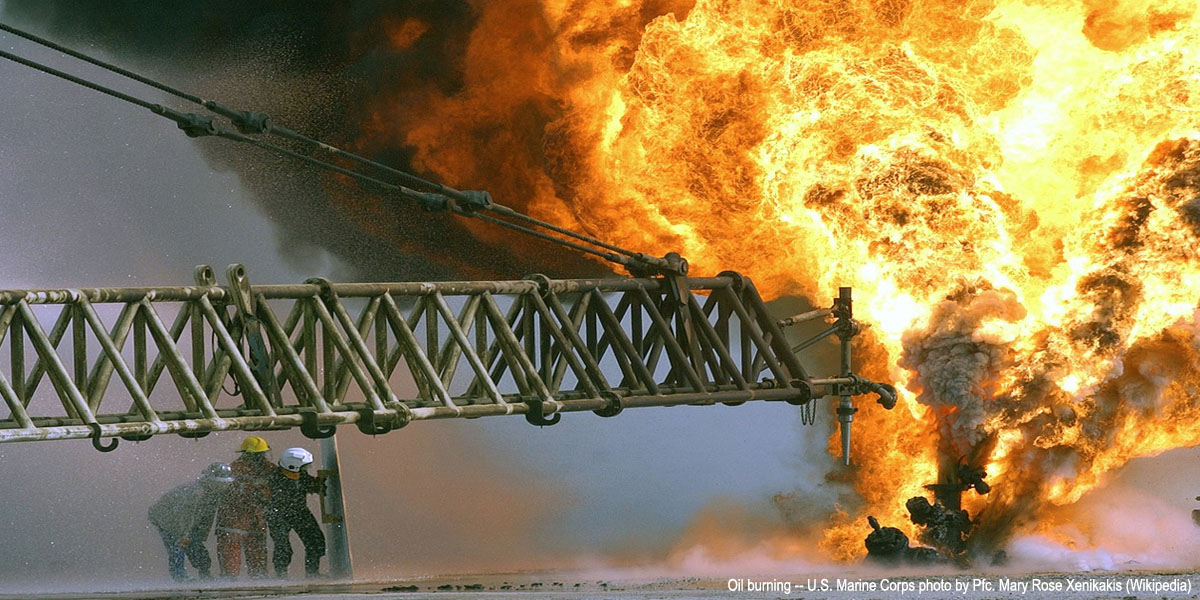




Comments
1) "The government is even doubling down, claiming we have to expand fossil carbon extraction because we need the extra fossil fuel cash to pay for emissions cutting."
Why accept that premise uncritically? Why not test it first?
In 2019 Canada's energy sector DIRECTLY contributed 7.2% to GDP. Including oil & gas, nuclear, hydro, coal, and renewables. Petroleum [oil & gas] accounted for 5.3%. Crude oil accounted for 2.8% (2017). The oilsands sector represents a fraction of that. Subtract (astronomical) externalized environmental, climate change, and health costs — and subsidies.
"Energy’s nominal GDP contribution for Canada" (NRCan)
• https://www.nrcan.gc.ca/science-data/data-analysis/energy-data-analysis…
*
A thriving oil industry will only delay the transition. A highly profitable oil industry will always seek to protect its profits. For decades, the fossil fuel industry has obstructed climate action.
Canada does not need fossil fuel dollars to fund the transition. Like selling cigarettes to cure lung cancer.
If Trudeau has billions of (our) dollars for pipelines, he has billions of dollars for renewables.
Transitions start by moving in the direction you wish to travel. Doubling down on fossil fuels takes us in the wrong direction. Building fossil-fuel infrastructure locks us into a fossil-fuel future. When you're in a hole, stop digging.
Wealth that degrades our life-support systems is illusory. The costs of climate change and fossil-fuel pollution are prohibitive. Hence, the need to shift away from fossil fuels ASAP.
How much are fossil fuel profits costing us? AB's oil & gas industry has barely started to fund its clean-up liabilities: upwards of $260 billion.
Prof. Naomi Oreskes: "The costs of climate change are so great that they now threaten the very prosperity that economic growth is intended to generate. So we can say we're interested in fossil fuel development, gas pipelines, or fracking, or tarsands… because they're going to generate economic growth. But the reality is that the cost of those things will be many times greater than the economic value that they produce."
Put a realistic price on carbon. End fossil fuel subsidies — or divert them to renewables and public transit. Invest in the solution, not in the problem.
2) "It's an audacious and risky climate message to send the world — that increasing fossil fuel production is compatible with climate safety."
Trudeau's climate message defies recent reports by the Int'l Energy Agency (IEA) and IPCC.
The 2018 IPCC Special Report on Global Warming of 1.5°C warns that the world must nearly halve GHG emissions by 2030 and eliminate them by 2050 to keep warming below the danger limit of 1.5 C.
IEA's Net-Zero by 2050 report says no new investment in fossil fuels after this year to contain global warming to 1.5 C.
The Liberals reject the IEA's conclusions and every IPCC report likewise. So does the oil industry.
3) "Curious whether any country has been able to pull off this seemingly counter-intuitive combo of extracting more while emitting less…"
The bulk of emissions occur at the consumer (combustion) end. Those emissions will still occur.
Net-zero upstream emissions targets are greenwashing. Capturing upstream emissions does not capture downstream (Scope 3) emissions at the consumer (combustion) end, which accounts for at least 80% of emissions from a barrel of oil. CCS does not address or capture other air pollutants.
Even if upstream emissions (from extraction activities) are reduced to zero, this does nothing to offset or reduce downstream (tailpipe) emissions at the consumer end. The oil industry has no way to decarbonize the downstream combustion of fossil fuels, where at least 80% of the emissions from a barrel of oil occur.
In short, the Liberals plan to fail on climate. The oil & gas industry and their financial/political backers are banking on global climate action failure. The only scenario in which oilsands expansion makes sense.
Great work, Barry.
I am curious about the emissions profile of exported oil. Using slightly outdated data from 2014, Canada exported 2.9 million barrels of oil and imported 636 thousand barrels per day, leaving a net export of 2.26 million barrels.
Natural Resources Canada pegs emissions from bitumen produced in the oil sands at about 550 kg CO2 per barrel in total, 150 kg emitted during production and 400 kg from combustion, mainly from tailpipes. This translates to 904,000 tonnes of CO2 released from tailpipes in 2014 in consuming countries, primarily the US.
Because Canada and especially Alberta practice a 19th Century natural resource extract-ship model, and where foreign ownership runs at about 70% in the oil and gas industry, and therein a lot of the diluted bitumen is piped to US refineries owned by American parents of Canadian subsidiaries, a significant portion of Canada's exported oil is refined and burned (both with big emissions profiles) in the US, creating piles of US fossil money from Canadian fossil fuels. We may be neck-and-neck with per capita emissions in the US, but how much of that is at its root Canadian in addition to our already terrible domestic per capita carbon profile?
When looking at Norway's resource management and wealth fund model, the latter initially taken from Peter Lougheed's Heritage Trust Fund idea, it makes Canadian petroleum businesses and the petro-governments in their pockets look like they are run by a bunch of rubes who gave away the store without one whit of attention paid to inconvenient external problems like potentially $300 billion in ground pollution cleanup costs, hundreds of billions in future climate adaptation measures and a reputation as a world class climate polluter.
France went electric, mainly with nukes. The UK is building offshore wind big time. The EU has tens of thousands of centralized wind and solar generation grids and decentralized rooftop solar everywhere, not to mention a really great interconnected electric train network, from high-speed intercity to metros and neighbourhood trams running in already highly walkable cities and towns. We can learn from them, and we can also explore deep carbon capture and sequestration through regenerative agriculture and plan for disruptive tech, like electric vehicles which are climbing into a place that will affect demand for Canada's oil.
This is to say that there is no shortage of ideas on how to address the problem, but there does seem to be a shortage of wisdom and courage and especially co-operation amongst decision makers that will delay climate mitigation even more. Sad.
Hi Alex,
Happy election day. :)
I think that this all goes back to Reaganomics and Thatcherism - an "easy answer" to 70's inflation and stagnation. Where the "magic" of the market was really more like the chaos of the feeding frenzy, with everyone ripping off a chunk for themselves and swimming away leaving the commons' carcass in tatters? Taxes-shmaxes? Policy-shmolicy? Wherever and whenever governments are corrupt or governance is absent we'll find (or soon find) the common good lying in tatters.
Layers of problems really, but at the heart of it is governance, and at the heart of that, is us. Why should any of these decisions to help avert climate catastrophe be considered controversial let alone 'courageous'? Is it that we're simply, collectively, too darn lazy or adverse to sacrifice? Sad is right.
Realistic tax on carbon? Sure, I'll suck it up and pay it if everyone else is. Full lifecycle costs for plastic? Why not? Make do with less, like our grandparents did? Can that be so hard, when frankly the alternative for our children, will really, really, really suck?
"...no amount of increased fossil carbon revenue has been enough to counteract the increased power that an expanding fossil fuel industry has to block progress. " We need to declare CAPP a terrorist organization.
Anywere, Anytime more Extraction of fossil fuels produces more Combustion which
produces more CO2. Therefore Canadian timid, Endentured Academics with
hundreds of eager, talented, Students from Canada and every Continent can
Utilize tonnes of Captured CO2 for new Products and Global Electrofication. Canada
already is a Leader.
Trudeau could get away with his BS when he was running the first time. Not so much anymore, now that Canadians have fairly ready access to truth-telling around climate, carbon, and the western provinces, in particular.